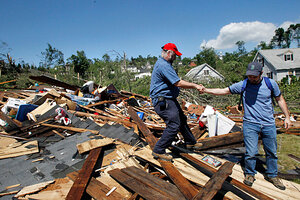Massachusetts tornado: What are deadly tornadoes doing way up in New England?
At least two tornadoes tore through communities in western and central Massachusetts Wednesday, killing four and injuring 200. They make 2011 the deadliest year for US tornadoes since 1950.

Shawn Menard (r.) reaches to help homeowner Tony Esposito from atop the rubble of his home in Monson, Mass., on Thursday, June 2, one day after it was destroyed by a tornado. Esposito said no one was injured at his home. Residents of 19 communities in central and western Massachusetts woke to widespread damage Thursday, a day after at least two tornadoes shocked emergency officials with their suddenness and violence.
Elise Amendola/AP
Hundreds of residents in western and central Massachusetts are combing through what's left of their homes and businesses after a convoy of severe thunderstorms traveled along the Connecticut-Massachusetts border late Wednesday afternoon and early evening, spawning at least two tornadoes and dropping golf-ball size hail in several locations.
So far, four deaths have been attributed to the twisters, which flattened wood-framed triple-decker houses and snapped tree trunks in at least 18 communities. At least 200 people were injured, according to emergency managers.
If the National Weather Service's Storm Prediction Center in Norman, Okla., can verify that figure, 2011 will tie 1950 as the deadliest year on record for tornadoes in the US, according to Greg Carbin, warning-coordination meteorologist at the SPC.
Earlier Wednesday, the center noted that conditions in Northeast would favor formation of severe thunderstorms capable of spawning tornadoes. By 2 p.m. EDT the National Weather Service had posted a tornado watch covering virtually the entire Bay State. The first reports of a twister began appearing around 4:30 p.m.
Speaking on ABC's "Good Morning America" on Thursday, Gov. Deval Patrick (D) noted that Springfield, Mass., residents had roughly 10 minutes' warning before the first tornado struck.
"When you consider how quickly the tornadoes developed and then touched down, the fact that there wasn't even greater damage and loss of life is a remarkable thing," he said.
The outbreak serves as a stark reminder that while much of America's tornado activity occurs in the Midwest and South, no region is immune. In addition to Massachusetts, Nebraska, Kansas, and northern California recorded tornadoes over the past 24 hours.
Although rare in Massachusetts compared with other parts of the country, tornadoes periodically etch their destructive paths across the state's landscape.
Between 1951 and 2008, the most recent year in which tornadoes struck, 152 twisters have been recorded in the state, according to the Tornado History Project, a nonprofit online database that draws on the Storm Prediction Center's records.
The most severe Massachusetts event occurred on June 9, 1953, when an EF4 tornado – the second most destructive category – spun through Worcester County in the central part of the state. During its 84-minute lifetime, the tornado traveled some 46 miles before vanishing. Some 94 people were killed.
The data from balloon-born measurements of the upper atmosphere gathered in Albany, N.Y., were "very impressive. There were a lot of conditions there that were favorable for pretty impressive storms," Mr. Carbin says.
The air at altitudes above about 10,000 feet was very cold and sat on a relatively thin, stable layer, or cap, of warm air that under other circumstances might have blocked the formation of the supercell thunderstorms that eventually appeared.
But close to the ground, temperatures were warmer than normal and very humid. As a cold front moved in from the west, it plowed into the warm air mass, forcing it to rise. The air was warmer than the air in the cap, allowing the rising mass of humid air to punch through and reach the much colder air aloft. There, the temperature contract fueled explosive growth of the thunderheads, while significant differences in wind speed and direction with altitude gave the storms the rotation they needed to favor tornado formation.
Wednesday's tendency of additional storms to build and travel along the path of their predecessors gave Springfield hits from two tornadoes and kept much of the southern part of the state under tornado warnings through most of the early evening.
